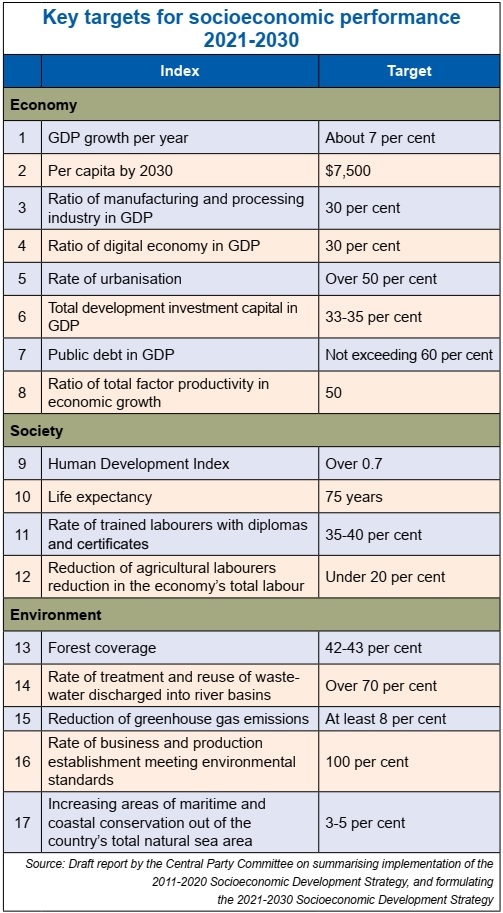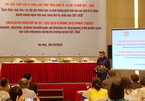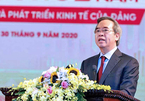with the role of the private sector in the economy to be further enhanced, creating a fairer playing field for enterprises across all economic sectors.
Vietnam’s most important political event of 2021, the National Party Congress, will see its 13th edition take place over a week from January 25 in the capital.
Its main duties consist of discussing and approving the political report, adopting Vietnam’s Socioeconomic Development Plan for the next five years and Socioeconomic Development Strategy for the next 10 years, amending Party statutes, and most importantly, electing the new Party Central Committee.
The newly-elected Party Central Committee will then convene its first plenum to elect the Party general secretary, the Secretariat, and head of the Committee’s Inspection Commission and its members.
The draft of documents to be discussed by the National Party Congress will cover vital issues for socioeconomic development over the next decade. Overall, they envision the country’s roadmap for the country’s development until 2030 and beyond.
“In the draft, Vietnam’s aspirations for further development for more prosperity and happiness are determined. This is one of the vital highlights in the drafts, reflecting the high expectations of people,” said Nguyen Viet Thong, general secretary of the Central Theory Council.
Overall, Vietnam aims by 2030 to become a developing nation with a modern industrial sector and a high middle-income level, as well as a modern management institution. It is expected that by 2045, Vietnam will become a high-income country.
 |
Private sector advances
Thong said that in a bid to accelerate economic restructuring, the congress’ draft stresses that it is a must to “restructure the system of enterprises in the economy, develop the Vietnamese business community, and boost the link between foreign-invested and domestic enterprises.”
According to the draft report by the Central Party Committee on summarising the implementation of the 2011-2020 Socioeconomic Development Strategy, and formulating the 2021-2030 Socioeconomic Development Strategy, the Party stressed that the Vietnamese private sector “must be strongly developed qualitatively and quantitatively, effectively, and sustainably, and be turned into a really important impetus for national economic development.”
“All obstructions and prejudice must be removed, while all favourable conditions must be created for the private sector to develop. The sector must be supported in innovation, technological modernisation, human resources development, and labour productivity improvement,” the draft report stated. “Major economic groups with strength and regional and international competitiveness are encouraged for development. Efforts are to be made to see at least two million operational enterprises which can create 60-65 per cent of GDP by 2030.”
In Vietnam, the private sector creates up to 40 per cent of GDP, over 50 per cent of economic growth, 30 per cent of the state budget revenue, and 85 per cent of the labour force.
Vietnam currently has nearly 800,000 operational enterprises, of which about 98 per cent are of small or medium size. According to the General Statistics Office (GSO), in 2020, there were nearly 135,000 newly-established enterprises, with total registered capital of over VND2.23 quadrillion ($97 billion), employing more than a million labourers. This was down 2.3 per cent in the number of registered enterprises, but up 29.25 per cent in registered capital.
In fact, the Party in 2017 issued Resolution No.10-NQ/TW on developing the private sector into an important impetus of the socialist-oriented market economy. According to many economic experts, Resolution 10 is an “enlightening resolution” for the private sector, handing it a clear, equal legality with other backbone state economic blocks.
Noticeably, entrepreneurial spirit spreads widely in society and the robust development of the private economy in some industries such as construction, processing, manufacturing, automobile, air transport, and finance and banking has shaped powerful and potential national brands for Vietnam.
According to the GSO, more than 3,000 innovative startups are in operation and many of them are very successful.
Ongoing investment selection
The country will continue shifting attraction of foreign direct investment (FDI) from quantity to quality, with high added value, and effectiveness and high technology considered the biggest priority in the country’s policy of attracting this type of capital.
“Effectiveness in wooing foreign investment cooperation must be increased, with selection and priority of projects with advanced technology and modern governance and high innovation, and especially having big spillover effects to and connection with domestic businesses,” the draft report read.
Vietnam is now drafting a new strategy for luring such investment for the years to come. According to drafters, this strategy is a roadmap for Vietnam to woo new-generation FDI, in a bid to further economic growth for until 2030.
Professor Nguyen Mai, vice head of the State Committee for Cooperation and Investment, which is now the Ministry of Planning and Investment (MPI), told VIR, “It is time for us to not only be interested in both registered and disbursed FDI, but also interested in directing it to the sectors prioritised for development in Vietnam, so that it can better serve national socioeconomic development.”
While talking about Vietnam’s success stories in luring global big groups such as Samsung, LG, Intel, GE, Mitsubishi, and Panasonic, World Bank experts said that despite the stories, Vietnam should seriously reconsider its FDI attraction methods, in order to determine sectors prioritised for foreign-invested projects, especially in the current context that Vietnam wants to upgrade its economy and seize opportunities brought about by Industry 4.0.
“Experts have been talking too much about Vietnam’s need to lure FDI with high added value, but they have failed to specify what sectors will have such investment. Thus the new attraction strategy must specify this,” said Simon Bell, senior consultant on investment policies from the World Bank, adding that this is one of the biggest challenges for not only Vietnam, but also for many nations that have succeeded in luring FDI in the first stage. The challenge is how to determine the sectors in need of such funding with feasibility and expectations.
Based on its studies, the bank has specified a series of new priority sectors for FDI attraction, such as high-quality metal, minerals, high-tech electronic spare parts, innovative and high-tech agriculture, and high-quality tourism services.
Besides this, Vietnam can in the short term focus the attraction of FDI into the sectors of manufacturing original technology and equipment, automobile equipment, and environmental tech. Longer term, priorities should be placed on production of pharmacy and healthcare, financial services, financial technology, IT services, and intellectual services.
Minister of Planning and Investment Nguyen Chi Dung said that Vietnam must seize opportunities from the ongoing shift of FDI flows amid the health currency.
“The government has established a special taskforce to welcome the new FDI wave as directed by Resolution No.50-NQ/TW dated August 20, 2019 on orientations to perfect institutions and policies as well as improve the quality and efficiency of foreign investment cooperation activities to 2030,” he said. “Vietnam has become a safe destination for investment, trade, and tourism. We need to attract more FDI, with a focus laid on major multinational corporations with high technology and leading supply chains and value chains. We also need to formulate a specific set of criteria for wooing them at any price.”
According to the MPI, Vietnam has so far lured over $383 billion worth of registered FDI for over 33,000 projects. From January until December 20, 2020, the total of newly-registered, newly-added, and capital contribution and stake purchases in FDI hit $28.5 billion, down 25 per cent on-year. Total disbursement in the period was nearly $20 billion, down 2 per cent on-year.
|
The 13th National Party Congress will discuss and adopt documents vital to national construction and development, including: - The draft political report, which is the central report of the event - The draft report on summarising the implementation of the 2011-2020 Socioeconomic Development Strategy, and formulating the 2021-2030 Socioeconomic Development Strategy. - The draft report on assessing the results of the implementation of 2016-2020 socioeconomic development tasks, and orientations and tasks for socioeconomic development for the 2021-2025 period. - The draft report on summarising the construction of the Party and implementation of the Party’s regulations for the 12th National Party Congress tenure. |
Khoi Nguyen (VIR)

Private sector, non-State enterprises to be placed at heart of 10-year development strategy
Enterprises, organisations and individuals have been called on to contribute to Vietnam’s draft socio-economic development strategy for the next 10 years.

Private sector – an important driving force of VN economy
The private economic sector's strong development to become an "important driving force" of the Vietnamese economy and other economic achievements have the contribution of the Central Economic Committee.